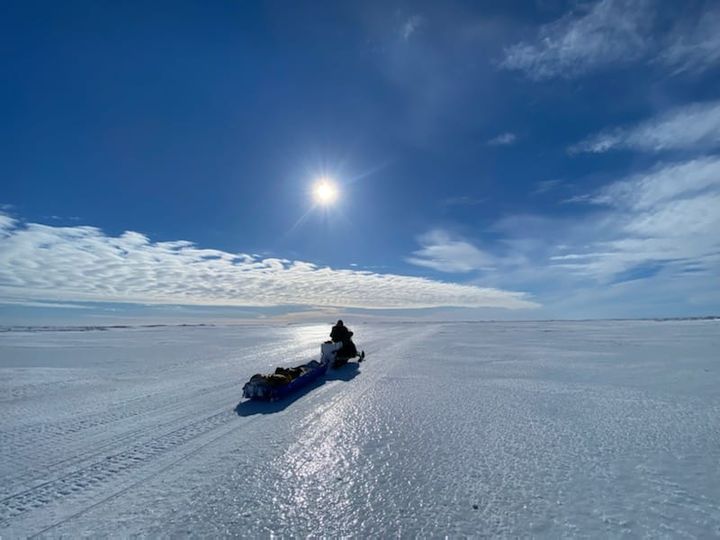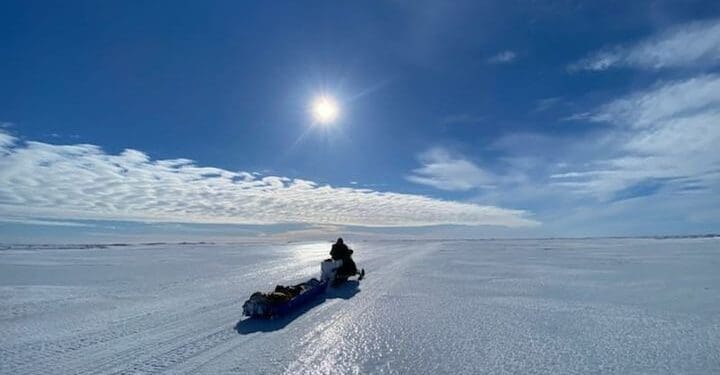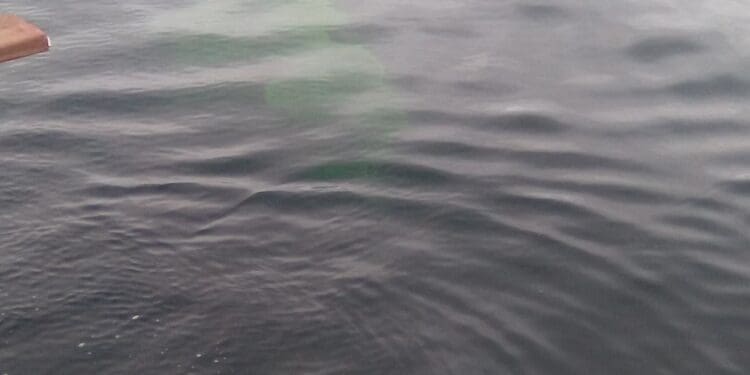
Author headed south from the Yukon River to the Kuskokwim River with a load of moose meat. Photo by Valerie Bue.
With Covid waning somewhat and a vaccine available, the stars otherwise lined up for another trip of a lifetime to hunt moose in the winter from Bethel. I arrived mid-day on Wednesday and Doug and Valerie had much of the trip preparations already taken care of. Their friend Phil would join us. Like Pat, he’s a wildlife manager for ADFG. I used Doug and Val’s extra snowgo, and Pat loaned us an extra tow sled. Weather was forecast in the 20’s with not too much wind.
We got started about 9 pm. We headed out of town. There was snow, but not much and certainly no new snow. The trail was hard and icy in most places, but not bad otherwise.
About 15 miles out, the mount on the main suspension shock on Phil’s snow go broke. We put Phil’s snow go into one of the tow sleds. Phil rode the snogo in the sled, and Dug said he could make engine sounds in his throat as he was towed back to town. We arrived back to Bethel, and Phil quickly swapped for another of his family snogos, and we were on our way by about noon.
Although I’d taken this same trip on the same trail a few years ago, it was like the first time. The earlier trip was thick fog, and while I returned on a fog tree trail that trip, the direction you are going in this country looks very different traveling north versus traveling south, as the horizon has different mountain ranges and hills in the distance. We passed some dead snogos on the trail. One that hadn’t been abandoned very long had a coat hanging from it, and that was kind of spooky.
We traveled north to the Yukon River, about 70 miles away. Most of the trip is over tundra, with increasing brush as you reach the Yukon River drainage. We stopped for lunch about half way there. We had made sandwiches of sliced moose roast, raw onion, and either mayonnaise or horseradish, and they were the best sandwiches ever. We made camp about 15 miles from the river in a rare stand of small spruce trees, which provide a good wind block. There were tracks everywhere as soon as we left the tundra and entered the brush. Fox, marten, lynx, moose, and maybe wolverine. After an hour setting up camp, we headed on to the Yukon River, arriving about 430 pm.
We crossed the river to an island covered in willows, the primary winter food of moose here. The willows were all about 7 feet tall, and not a single tree was unmolested. And, there was lots of moose scat. Clearly, there were lots of moose here. It took perhaps 15 minutes, when we started seeing moose, then more moose, and more moose. Groups of one or two here, 3 or 4 there, and some groups even bigger. The moose were a little nervous as I would stop to try for a shot. It wasn’t about closing the distance, but getting a clear shot at the vitals. Much of the time the moose was standing in the brush, with only the upper shoulder, hump and head visible. I’m not comfortable shooting a moose in the head at any distance over 20 yards as there’s so much mass there that could simply injure the animal, and not kill it.
Phil and I were the shooters, and he soon took a fork in a trail when he saw a moose. I continued traveling the trails, trying for a shot. Finally, a cow presented herself for a shot, and she fell where she stood. Phil already had a moose down, and I looked for more as the limit is two moose. Thankfully, I got my wits about me and thought – lets process these two first before we take any more. We’d already arrived late, and it was slowing moving towards dusk.
I’d taken a very large cow. I pulled up alongside her with my snogo and sled. Doug unhooked the sled, and slid it under the side of the moose. Doug, Val and I then all got on one side of moose, and pushed for all we were worth and it piled right into the sled. I hooked up the sled, and returned to the fork where I left Phil, unhooked my sled, then proceeded to find Phil, who was not far down the trail working on his animal, also a large cow.
The 4 of us butchered Phil’s moose. We didn’t keep the hide, and laid the moose pieces on a tarp on the sled, and then bundled up the tarp to keep the moose in place and protected. The sun was setting as we moved the short distance up the trail to my moose. We broke our headlamps out, and took a little break to stretch our backs before starting in on the butchering. A nice moose came out in the open right next to use not 50 yards away. I don’t think any of us thought it would be a good idea to take a third moose. Moose hunting here is like subsistence fishing for salmon. Not with a gillnet though, since you can set out your net into a school of fish and before you can get it in, have way more than you want. Moose hunting here is more like dipnetting. You can meter your harvest and quit before you get too many.
Doug and I discussed this massive animal we were slowing taking apart. How would I ever pack a quarter if I had to? Could I ever do it? They just seemed too heavy to imagine I could. The four of us got the hide off. Phil and Doug then did the cutting while Val and I did the the pushing and pulling of the limbs to get the quarters off. Then Phil and Doug worked their knives around the brisket. They pulled the brisket plate off, then pulled on the rope we’d tied around the esophagus and trachea to pull these towards the back, and then all the insides piled out of the moose. Next Doug started cutting off the rips while Phil worked on the neck. We cut the backbone in about half, loaded all the parts on the tarp in my sled, piled the tarp around the meat, and headed for camp. Snow white ptarmigan with their jet black tails exploded on wing in front of us as we traveled through the edge of the willows,
We arrived at camp about quarter past midnight. Valerie had made chicken and potato salad the day before for our dinner, but everyone decided to just crawl into our sleeping bags and hit the hay. What a day. Lucky for me, Phil had brought some super cool and skookum cots for the two of us. Called Roll a Cot, they only weigh 10 lbs, fold up into a compact carry, and are stout enough to hold my lard ass. Having learned from Brian than cots make all the difference in camping, I was thrilled. I felt guilty when Val harassed me the next day about not being a gentleman and offering her my cot, but I got over it pretty quick. She’ll have a cot to sleep on soon enough.
We got up the next morning about 8 am. It was well after sunrise, which surprised me when I exited the tent, since the double walls of the arctic oven blocked out the early morning sunlight. Of course we were all famished now, and Doug passed around the chicken. He also handed out some large chocolate covered salted caramel candies. The coffee in my thermos was still warm. When Phil started the fire in the little wood stove for the tent, we reheated the coffee in a pan, and enjoyed relaxing sitting on our cots and sipping coffee. Phil asked if I’d punched my tag and I realized I hadn’t, so I did that right then before I forgot.
We were in no hurry now. Doug tried to bait us to go back and get more moose, but nobody bit. We leisurely dismantled camp, loaded up our sleds, adjusted our facemasks and goggles, and headed for town in lovely spring weather of about 20 degrees. Like last year, when we got near Bethel, we took a different route out to the Kwig River and then to the Kuskokwim. It was Friday now, and lots of activity. Lots of trucks were in one spot with people jigging for pike through the ice. Trucks were headed upriver on the ice road, some likely headed for Aniak for the camp out race back to Bethel the next morning.
We worked our way back to Bethel. When we arrived back at the house, we stretched our bones for awhile. I helped Doug put together a rack in his shed to hang our meat. He then cut several pieces of cord for hanging. Doug and I then manhandled the quarters into the shed and hung the quarters from the rack with the cord. Now it was time to really relax. We had soup with fresh moose for dinner. Doug played a legendary cd of music about Bethel called Paris of the Kuskokwim, and I enjoyed it so much I ordered it online for home. Now that I’ve been to town a few times, I at least sort of get the fun in the songs.
Val and Doug invited Pat and Louise and Sam and Santina and their kids for dinner the next day, as they wanted to hear about the hunting. Val broke out some of the halibut I brought out with me for them to make her signature halibut pie. Conversation centered around hunting and trapping. And dog mushing. Dog mushing in Bethel is like hockey in Minnesota or wrestling in Iowa. Everyone knows the mushers personally, having either grown up with them, or worked or socialized with them in the community, and/or married into their families. There was a weekend race going on called the camp out race, I think. The mushers run their dogs or drive with their teams in their vehicles up the ice road on the Kuskokwim River to Aniak, camp over night, and then race back to Bethel the next day. Non-mushers go up and camp and follow the teams back to Bethel as well. There may have been some prize money, but it wasn’t much. The race is more of a fun run and spring tradition.
On Saturday, Doug and I started in on the butchering in the shed while listening to old time country music on KYUK until it was time for the March Madness games streaming on XM radio on my phone.
I deboned the four quarters into game bags, and each quarter averaged about 45 lbs each in meat. Doug cut the ribs to size for their instapot, They love moose ribs, and there’s lots of ribs on a moose. Doug also trimmed the meat off the neck, which is considerable. We then cut out the back straps, the meat between the ribs below the back straps, and the tenderloins. Doug and Valerie ground this for burger and it totaled 50 about 1 lb packs, and they were happy campers. We saved the bones and brisket for their neighbor, and also trimmed a front quarter that Pat gave her.
The Camai dance festival was also going on. It’s a big deal, with dance groups from all over coming in, and this year’s event was the first semi-normal one after the event was cancelled for the past year or two due to Covid. Louise mentioned there were vendors selling wares. I noticed she was wearing some ivory earrings of Billikens. I thought- I should have gone over to get something for Sara. Of course I had this revelation on Monday, after the event was over. I asked Louise about earrings, and luckily she found some vendors were advertising on Facebook after the dance. I found some earrings I thought Sara would like, and arranged to go get them after Doug and I returned from checking his traps.
On Monday, we headed out to some beaver ponds not far from town on the snogos to check Doug’s sets. He had three sets of 330’s set for beaver and otter. We took .22’s in case we found some ptarmigan. The sets were empty, and Doug reset them all. We got near a small flock of ptarmigan on the way home, and Doug got one. Doug sent me a photo today and said he got a beaver in one of the sets.
We ran over to get the earrings. I was met by a nice elder woman who thanked me in Yupik for buying her creations. We refilled the gasoline jugs we’d used on the hunting trip, and I was surprised to see the fuel price was the same as Juneau. Modern snogos seem incredibly efficient, as Doug thought we’d burned about 10 gallons per machine going to and from the Yukon River, including the switch back for Phil’s sled. And pulling all the camping gear and moose in the tow sleds.
One of Val and Doug’s good friends, and also a friend to my niece, asked us over for dinner on Monday. They have a new house on Brown’s Slough, and their 2 year old is like a grandson to Doug and Val. The mother is a nurse at the hospital, and dad works on the slope. The chili for dinner was made from chicken and white beans. I’d never had it before and it was fantastic. The couple had grown up together in Bethel and loved living there, it seemed.
The meat I brought home as luggage made it fine in two 33 gallon totes, and the meat I air freighted in two similar totes came in early the next morning. I butchered one tote of meat after working my part time job back at ADFG before the scout meeting, then a second tote after the scout meeting. I did about 90 lbs in 5 hours, so about 18 lbs an hour is my rate to dissect, trim, portion, bag, vac pack and put the meat into the freezer. Why I care about this measure, I don’t know. I did the front quarters tonight, and they took a little longer, but Sara helped by doing the vac packing and labeling. Part of the satisfaction of butchering is thinking about the whole trip you did getting the meat.
We had moose pepper steaks with onions and peppers over fresh salad both nights.



